Main Report of the National Review of Primary Care Out of Hours Services
The Main Report of the National Review of Primary Care Out of Hours Services setting out the approach, detailed findings and rationale for the recommendations proposed together with a range of supporting documentation provided in annexes.
Annex B: Key Facts about Services
Background
Much of the statistical information requirements for this Review was prepared by Information Services Division (ISD), National Services Scotland. Scottish Government recently commissioned ISD to develop and introduce a dataset to collect information on GP OOH services across Scotland. National data collection began in April 2014. ISD published its first report for the period 1 April 2014-31 March 2015, in August 2015:
Use and Provision of Services
Note: Data are from 1 May 2014 to 30 April 2015, except where stated - this period was chosen to give the most recent and robust data.
NHS 24
- There were just under 1.3 million calls to NHS 24 - 25% of callers are given self care advice; 40% are directed to a Primary Care Emergency Centre (PCEC); 12% are visited at home, 10% receive GP telephone advice; 7% are advised to attend Accident and Emergency (A&E) services, 6% are transferred to 999.
- The following diagram presents information on the outcomes of NHS 24 calls (for example home visit, PCEC, no partner action) in the OOH period by age group:
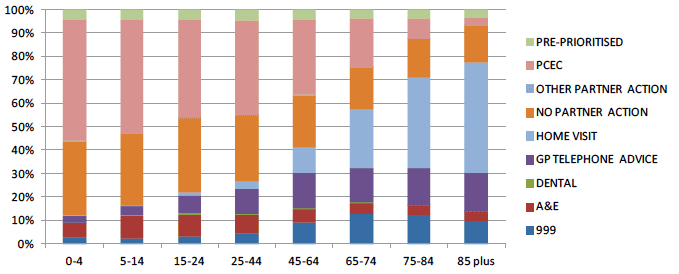
- The demand for NHS 24 services has been steadily increasing with a significant (20%) increase after the introduction of the NHS 111 number.
- 49% of callers to NHS 24 were from the top two most deprived - Scottish Index of Multiple Deprivation (SIMD) - areas.
- NHS 24 operates a number of contact centres, one of which is stand-alone at Clydebank. Contact Centres at Cardonald, South Queensferry and Inverness are co-located with the Scottish Ambulance Service.
- In addition to responding to urgent advice calls NHS 24 also offers a range of health information services providing information on a range of illnesses and conditions and treatments. NHS 24 holds details of pharmacy opening times and GP and dental practices and coordinates the confidential phone-line service Breathing Space for people experiencing low mood or depression. Further details are available on the NHS 24 website, including a self-help guide: http://www.nhs24.com/explained/services/
Primary Care OOH Services (OOH services)
- At present there are 64, Primary Care Emergency Centres (PCECs) in Scotland. These are stand-alone units, most of which are co-located or in close proximity with Emergency departments at Acute Hospitals and some are co-located with minor injury units/community hospitals. This compares to 980 GP Practices in Scotland where daytime services are provided.
- Almost 1 million contacts (997,112) were made with OOH services between 1 May 2014 to 30 April 2015, an average of ~75, 000 per month peaking in January 2015 (88,414). This compares with 900,000 ED/A&E attendances in the OOH period amounting to 56% of their total workload.
- Three out of four contacts with OOH services come via NHS 24. 56% of patients are seen at a Primary Care Emergency Centre, 19% have a GP or nurse practitioner home visit; 21% will receive GP or nurse practitioner telephone advice. The remaining 4% are provided by other clinicians including community psychiatric nurses. At present it is estimated that around 20% of all consultations are carried out by nurse practitioners with a wide variation between Health Boards (1%-33%).
- Gender - Female contacts with OOH services account for 59% of all contacts, mirroring contacts with NHS 24.
- Patients aged over 75 years accounted for nearly 20% of the patients treated - this represents 8% of the Scottish Population. Those 75 and over are more likely to receive a home visit. Those aged 4 years and under are most likely to be seen at a PCEC. 48% of people attending PC OOH top two most deprived - Scottish Index of Multiple Deprivation (SIMD) - areas
The following diagram presents the type of consultation (attendance at PCEC, home visits, GP OOH advice call and other) and is based on the last consultation recorded for the patient.
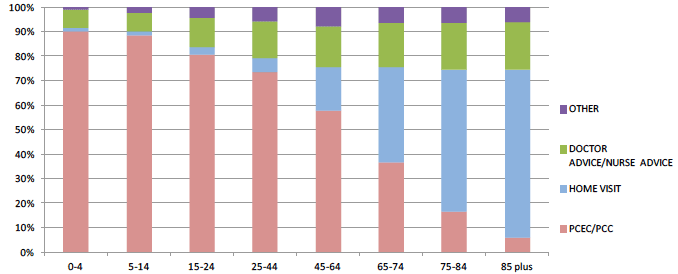
- Home visits are slightly higher in more rural NHS Boards. However there is some variation between NHS Boards in the type of consultations recorded.
- At present there are 64 Primary Care Emergency Centres in Scotland. Most Health Boards have at least one of these centres co-located with emergency departments at acute hospitals or with minor injury units/community hospitals. This compares to 980 general practices in Scotland where daytime services are provided.
The Scottish Ambulance Service (SAS)
- SAS dealt with 740,631, 999 and GP urgent calls during the financial year 2014/15. Of these around half a million occurred in the OOH period, of which SAS attended 378,879 incidents.
- Of those that they do not attend, the patients may be passed on to NHS 24 and others do not require any input following further triage by SAS. As with other OOH services, demand has been increasing by 11% between 2010 and 2014.
- Just over half of the calls to SAS are initiated by the patient (family member/bystander/care home) and one in five come via NHS 24.
- The majority of people are conveyed to A&E or to a hospital (presently around 75%).
- Increasingly SAS are delivering See and Treat services i.e. they will treat an individual at the scene of the incident, rather than take them to hospital. This presently accounts for around 17.5% of calls in the daytime and OOH period. SAS will also transfer about 4% of their calls to NHS 24 or a clinical advisor.
- The over 75 age group account for 26% of patients treated/conveyed by SAS.
- 44% of SAS incidents were in the top two most deprived SIMD areas
- SAS presently operates from three national control centres at Cardonald in Glasgow, South Queensferry and Inverness.
Accident and Emergency (A&E) Services
- There are around 1.6 million attendances at A&E services (emergency departments and minor injury units) across Scotland annually, ~883000 (54%) occurring in the OOH period. This compares directly with ~997,000 contacts with OOH services.
- The majority (57%) - self refer i.e. they have had no contact with a health care professional prior to their attendance. SAS are recorded as bringing about 26% of people to A&E services, NHS 24 will refer around 5% and around 2% are referred by OOH services.
- The 75 and over age group are more likely to be brought to A&E by an ambulance whereas the younger age groups are more likely to self refer.
- 2 in 3 people (67%) are discharged home from A&E and 27% are admitted to hospital. A small percentage (2%), are re-directed to PC OOH services.
- 52% of people attending A&E were from the two most deprived SIMD quintiles (a similar figure for NHS 24, OOH services and SAS activity).
- People from the most deprived SIMD quintile (29%) made twice as many A&E attendances of those in the least deprived SIMD quintile (14%).
- Proximity to A&E services is a large factor in attending - those who live closer to emergency departments and minor injury units are more likely to attend there to seek help.
- There are 30 emergency departments presently in operation throughout Scotland, as well as 63 minor injury units, community hospitals and health centres which carry out A&E related activity, typically GP or nurse led.
Contacts with all OOH NHS Services by Age Group
The diagram below provides an age-profile of contacts for primary care OOH, NHS 24, SAS and A&E services, noting in particular the demands of the youngest (<5 years) and oldest age (75+ years) cohorts on primary care OOH services and NHS 24 and the highest use of SAS by people aged 75+ years.
Contacts with OOH Services by Age Group
May 2014 - April 2015
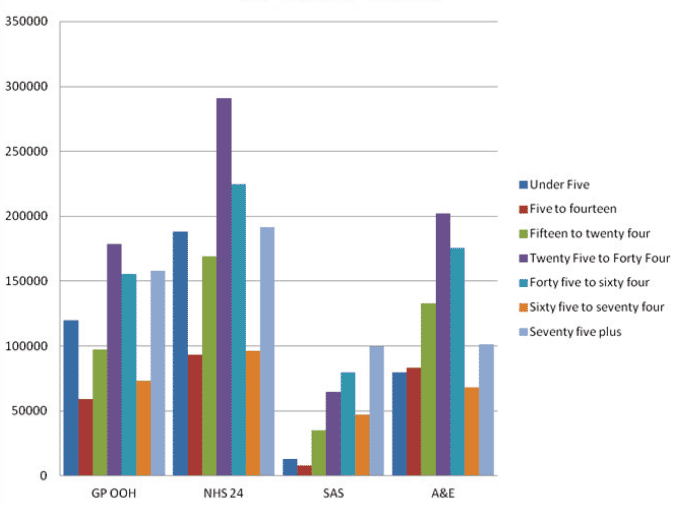
Population Projections for Scotland
- The population of Scotland is projected to rise from 5.31 million in 2012 to 5.52 million in 2022, and to continue to rise to 5.78 million in 2037 - an increase of 9 per cent over the 25 year period.
- Over the next decade, 28 per cent of the projected increase in Scotland's population can be attributed to natural increase (more births than deaths) while 72 per cent of the increase is due to assuming continuing inward net migration to Scotland.
- Between 2012 and 2022 the number of children aged under 16 is projected to increase by 4 per cent from 0.91 to 0.95 million. It is then projected to increase to 0.96 million by 2037 (a 5 per cent increase compared with the 2012 estimate).
- The number of people aged 75 and over is projected to increase by around 28 per cent in the first ten years of the projection period, from 0.42 million in 2012 to 0.53 million in 2022. It is then projected to continue rising, reaching 0.78 million in 2037 - an increase of 86 per cent over the 25 year period.
- The number of people of working age* is projected to increase from 3.35 million in 2012 to 3.51 million in 2022 (an increase of 5 per cent). The projected working age population then decreases to 3.48 million by 2037 (an overall increase of 4 per cent from the 2012 estimate).
- The number of people of pensionable age* is projected to decrease from 1.05 million in 2012 to 1.02 million in 2020 (a decrease of 3 per cent).
*To see foot note in next page qualifying working and pensionable ages.
Source: National Records Scotland
Projected population of Scotland (2014-based), by age group, 2014-2039
| (1,000s) |
||||||
|
|
2014 (base) |
2019 |
2024 |
2029 |
2034 |
2039 |
|---|---|---|---|---|---|---|
| All ages |
||||||
| 0-15 |
911 |
922 |
931 |
926 |
929 |
924 |
| 16-29 |
976 |
938 |
889 |
884 |
900 |
902 |
| 30-44 |
1,019 |
1,020 |
1,085 |
1,093 |
1,051 |
1,010 |
| 45-59 |
1,157 |
1,151 |
1,065 |
1,009 |
1,012 |
1,078 |
| 60-74 |
851 |
923 |
987 |
1,058 |
1,059 |
984 |
| 75+ |
433 |
474 |
557 |
626 |
707 |
803 |
| Median age(years) |
41.9 |
42.4 |
42.9 |
43.5 |
44.3 |
45.2 |
| Children |
911 |
922 |
931 |
926 |
929 |
924 |
| Working ages1 |
3,377 |
3,478 |
3,492 |
3,525 |
3,457 |
3,419 |
| Pensioners1 |
1,059 |
1,028 |
1,092 |
1,145 |
1,273 |
1,359 |
Footnote
1. The figures for working age and pensionable age and over, take into account the changes in the State Pension Age (SPA) as set out in the 2014 Pensions Act. Between 2014 and 2018, the state pension age will rise from 62 to 65 for women. Then between 2019 and 2020, it will rise from 65 years to 66 years for both men and women. A further rise in state pension age to 67 will take place between 2026 and 2028. Between 2044 and 2046, SPA will increase from 67 to 68. The UK Government plan to review state pension age every five years in line with life expectancy and other factors. (Not all figures will sum due to rounding).
© Crown copyright 2015
Projected population of Scotland (2014-based), by age group, 2014-2039
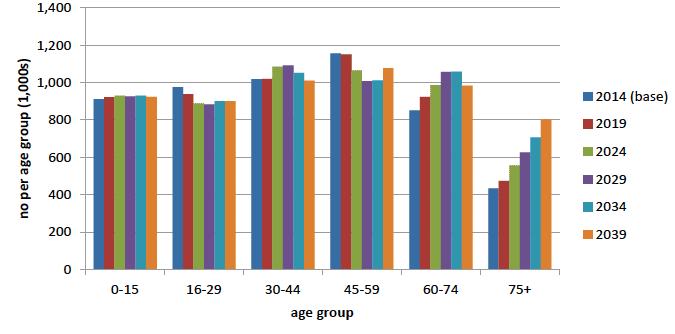
Potential Impact of Population Change on Future Service Demands for the OOH Period
The figures here have been sourced from ISD and are unpublished. Please note these are estimates only based on current service use and must be carefully recalibrated with the passage of time. Service demand patterns may change by factors other than population change and indeed emphasises the importance of resilient new models of community based urgent care for this particular age-group, not only by number but by complexity - with many having multiple chronic conditions.
- Currently the over 75 years age group and the under 1 year age group are high volume users of OOH services.
- The projections show that the majority of age groups who use services in the OOH time period, will increase slightly or remain fairly stable over the next 20 years. This includes the under 1 year age group.
Service projections for the over 75 age group
The over 75 age group using services in the OOH period is projected to increase by ~32% by the year 2024 and ~66% by the year 2034 as follows:-
- PC OOH services - the over 75 age group had ~170,000 contacts in 2014. This is projected to increase to ~224,000 in 2024 and ~283,000 in 2034
- A&E - the over 75 age group had ~99,000 attendances in 2014. This is projected to increase to ~131,000 in 2014 and to ~165,000 in 2034.
- NHS 24 - the over 75 age group called NHS 24 ~188,000 times in 2014. This is projected to increase to ~247,000 in 2024 and ~312,000 in 2034.
- SAS - the over 75 age group had ~101,000 incidents responded to by SAS in 2014. This is projected to increase to ~133,000 in 2024 and ~169,000 in 2034.
- Emergency admissions to acute hospitals (all time periods - not just OOH as time of day of admission is not collected) - the over 75 age group had ~149,000 emergency admissions in 2014. This is projected to increase to ~197000 in 2024 and ~248,000 in 2034.
Community Pharmacy
- There are currently some 1,250 community pharmacies located across Scotland offering a range of services and healthcare advice to patients and the general public.
- Service developments, implemented within community pharmacy, have led to pharmacies becoming an important access route for people reinforcing pharmacies role as a first point of care. This is particularly important in the OOH period.
Minor Ailments Service
The Minor Ailment Service (MAS) allows eligible individuals to register with and use a community pharmacy as the first port of call for the treatment of common illnesses on the NHS.
- A patient registers with the community pharmacy of their choice in order to use MAS. Once registered, they can present at any point with symptoms and the pharmacist, having ascertained whether the patient is still eligible to use the service, will treat, advise or refer them to another health care practitioner where appropriate.
- At 31 March 2015, nearly 18% of the population of Scotland were registered for the Minor Ailments Service, a total of 913,483 people.
- Over 2.1 million items were dispensed under the Minor Ailments Service, accounting for 2.2% of all items dispensed by community pharmacies in Scotland. This service is only available to a subset of the population.
The National Patient Group Direction (PGD) of the Urgent Supply of Repeat Medicines and Appliances
- PGD are written instructions for the supply or administration of medicines to groups of patients who may not be individually identified before presentation for prescribing treatment.
- By using the national PGD for the urgent supply of repeat medicines and appliances pharmacists can provide a supply of the patient's medicine for up to the equivalent of the quantity of medicine normally prescribed for the patient.
- Over the period 1 April 2014-31 March 2015, community pharmacies supplied 266,614 items using the national PGD (compared to 997,112 OOH service contacts in the same period). It is likely that the absence of this service would lead to a significant increase in OOH services contacts.
Direct Referral of Patients to OOH Service Services
- Pharmacists who wish to refer patients to OOH services or other local health service, complete a Direct Referral Form Template.
Health Protection Scotland
Health Protection Scotland (HPS) is the national centre for communicable disease and environmental hazard epidemiology, control and prevention. It has a critical interface with Scotland's OOH primary care services.
- HPS is the centre of key knowledge relevant to the control and prevention of communicable disease and environmental hazards. It has the role to communicate information and disseminate alerts to a variety of agencies including OOH services.
- HPS gathers this knowledge from a number of areas, local NHS Board intelligence and interrogation of various datasets.
- HPS is responsible for the training of the local NHS Board health protection workforce. OOH services are provided information and intelligence by HPS and can respond to queries from OOH primary care personnel.
- HPS runs a 24/7 operational support and advisory service which is designed to support Health Protection teams in NHS boards. However, in certain instances, particularly those relating to serious incident responses such as Pandemic Flu, HPS coordinates national multi-agency, multi-disciplinary responses which have a direct interface with OOH services.
- Information and intelligence are frequently transmitted between HPS and NHS 24 to ensure optimal awareness of urgent public health issues such as patterns of communicable disease including influenza/influenza-like illness.
Social Services
Background
- Across Local Authorities OOH (emergency provision) is variable in terms of the model of service provision. Some Local Authorities provide this service on an individual basis, others do so on a shared basis with service level agreements in place. The operating model and the service provision (this includes the operating hours), will differ. The interface with primary care OOH services will also differ across localities.
- Within local authority OOH provision there will be qualified Social Workers within the team. The primary function of the OOH services is to deal with urgent and emergency situations that arise OOH i.e in evenings, over weekends and on public holidays when not all social work provision is available. Within the teams there is a focus on statutory provision in terms of safeguarding and protection both in terms of Children and Families and Vulnerable adults which may require interventions within the legislative framework of Child Protection, Adult Support and Protection, Adults with Incapacity and Mental Health legislation. The teams also provide support in terms of accessing social care/nursing care OOH where this is required, for example, where a frail older person has an event that requires an emergency response. Professional staff within the local authority OOH teams require to work with OOH primary care teams to discharge the functions described above. The links with primary care OOH services work well in many instances but there can also be challenges. One particular challenge is the variability that local authority OOH teams experience when seeking to access mental health provision from health colleagues.
Care Setting
- The majority of older people live in their own home (or with family). Of people aged 65 and over 3.3% were living long term in a care home in 2014. Amongst people aged 85 and over most live at home, with about one person in six living in a care home.
- By 2014 around 16,500 people aged 65+ were living in residential care. A further 15,000 received a package of home care of between 5 and 10 hours per week, and 18,500 a package of under 5 hours.
- In 2014, 111,940 people in Scotland were in receipt of telecare (community monitoring) provided by their local authority. The national statistics reporting the provision of these services show a steep age gradient in provision: 3.5% of people aged 65-74 and 13% of people aged 75-84, escalating to one person in three aged 85.
Residential Care
The Care Home Census publishes information on numbers of care homes, residents and registered places at Scotland level. Residential care may be required for adults who are unable to remain safely in their own home due, for example, to frailty in old age or disability. Local Authorities may provide funding for residential care. depending on assessment of need and financial situation. Care homes may provide long stay, short stay and/or respite care. They may be run by Local Authorities/NHS, private companies (independent sector) or the third sector; they are all registered with and regulated by the Care Inspectorate.
Please note these figures are as at 31 March 2015:
- 36,193 adults were in residential care homes.
- 42,026 places were available in 1,216 care homes for adults in Scotland.
- 73% (892) of care homes provided care to older people.
- 58% (701) of care homes providing 31,566 places to 27,064 residents were run by the private sector.
- 28% (337) of care homes providing 5,780 places to 5,212 residents were run by the third sector.
- 15% (178) of care homes providing 4,680 places to 3917 residents were run by Local Authorities or NHS Boards.
- 89% of long stay residents in care homes are aged 65 and over.
Number of Long Stay Residents in Care Homes
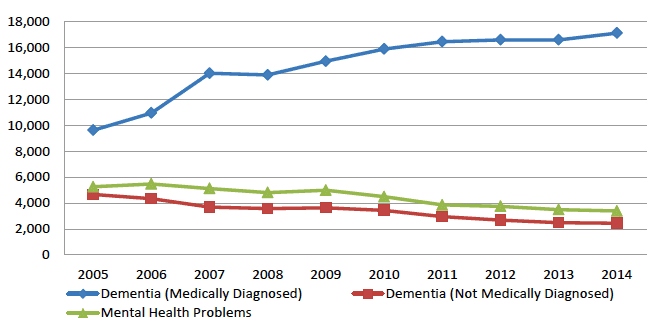
Selected demographic information is collected for long stay residents only. The above figures show the trend in the number of long stay residents in care homes for selected mental health conditions. The number of long stay residents with a medical diagnosis of dementia has almost doubled over the last ten years.
Trends in Residential and Hospital Care
- Compared to 2008/09, by 2013/14, each day on average around 1,300 'fewer than projected' people aged 65 and over were in hospital following an emergency admission.
- When the differences against the 2008/09 position in both the emergency hospital bed use and the use of care homes are taken together, it is possible to conclude that on average about 5,300 fewer older people per day were in a hospital or care home by 2014. In other words, older people spent almost 2 million more days and nights at home in 2013/14, than would have been expected had the 2008/09 rates for institutional care continued.
- These differences indicate the important role of prediction of trends for future service demands but also the importance of continuous monitoring to ensure the robustness of future forecasting.
Third sector
The role of the third sector in health and social care
The Third sector is a major provider of health and social care services, which is contributed over 24 hours - both the daytime and OOH period. The wider activity of the third sector keeps people connected, promotes health and wellbeing and is organised in distinctive ways:
- Many third sector organisations are community-based, which provides them with a detailed "bottom-up" understanding of the issues affecting peopleʼs lives and an ability to reach and relate well to people in need.
- Third sector governance is voluntary. While board members of third sector organisations will have to declare an interest or a conflict of interests, their stake in them is cause-related, rather than financial.
- Any surpluses generated by third sector organisations are reinvested in their good cause, rather than distributed for private gain.
- Generally, third sector organisations are flexible and can respond quickly to emerging or changing needs.
Examples of third sector activity:
- Prevention, supporting self-care and self-management
- Supporting people with learning difficulties, long-term conditions
- Counselling, mental health and recovery support
- Addiction services - alcohol and drugs
- Children's and older people's services
- Palliative care
- Provision of health and social care services
- Supporting people who are lonely, befriending
- Cognitive and physical impairment
- Provision of aids and adaptations, care and repair schemes
- Supporting carers
- Shopping services
- Community food and health initiatives, patient transport, volunteer driver schemes
- Accommodation, housing and tenancy support
- Advocacy, advice and information
- Human rights, social enterprise, volunteering
The third sector workforce
55% cent of the sector is employed in social care or health, with a further 17% employed in housing, which has vital link with health. The Third sector workforce is growing, which demonstrates the interest in community-led, third-sector enabled response to the complex issues, which affect many lives of people living in Scotland.
The size and shape of the sector
The third sector in Scotland is made up of around 45,000 organisations, large and small - charities, community groups, social enterprises and voluntary organisations. They have a collective annual income of £4.9 billion and deliver a range of good causes with support of 1.3 million volunteers, 180,000 trustees and 138,000 paid staff. There are more third sector organisations in rural than in semi-urban communities in the central belt. This difference is likely due to the thinner spread of public services, the limited size of market for the private sector and the need for people to do more for themselves and each other. The Shetland Islands, the Western Isles and the Orkney Islands have the highest number of charities per 10,000 of population, while North Lanarkshire, South Lanarkshire and Falkirk have the lowest number.
See also: The Scottish Council for Voluntary Organisations (SCVO)
http://www.scvo.org.uk/
A Local Information System for Scotland (ALISS)
https://www.aliss.org/
Contact
Email: Diane Campion
There is a problem
Thanks for your feedback